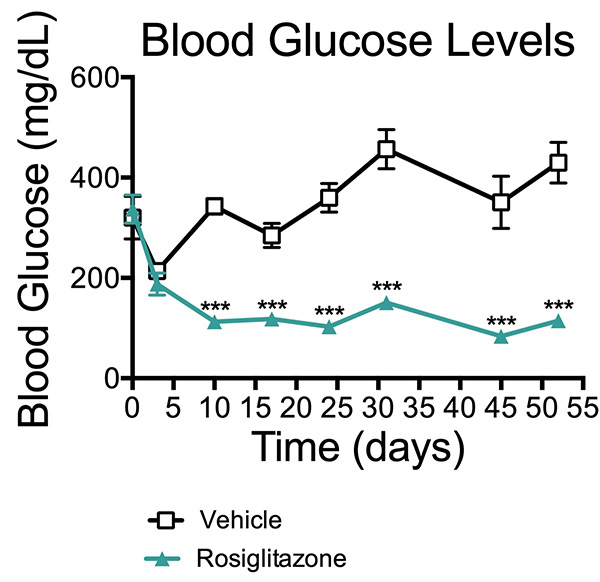db/db Mouse Model of Type II Diabetes
Discover how Melior’s unique phenotypic screening platforms can uncover the untapped value of your candidate therapeutic
Type II diabetes is characterized by high blood glucose levels, insulin resistance, β-cell loss, as well as a predisposition towards obesity and dyslipidemia. While there are many animal models of type II diabetes that demonstrate impaired glucose tolerance under a glucose challenge (see OGTT mouse model), the db/db model is a well-accepted type II diabetes model that recapitulates most aspects of the human disease.
Db/db mice express mutations in leptin receptor that lead to obesity, decreased insulin receptor sensitivity and subsequent increased levels of blood glucose, decreased β-cell function, and elevated HBA1c levels.
Like human Type II diabetes, the diabetic condition in db/db mice is progrssive. Animals have near normal or slightly elevated fasting plasma glucose (FPG), and relatively normal β-cell function at 6 weeks of age. FPG levels gradually elevate over several weeks and β-cell function declines such that by about 16 weeks in age FPG is very high (> 400 mg/dL) and β-cell function has entirely degenerated.
Since the db/db model has the feature of overt insulin resistance, progressive development of hyperglycemia and β-cell dysfunction with age, it has the merit of having close clinical relevance to human type II diabetes.
Compounds from essentially all approved classes of anti diabetic agents can effectively improve glycemic control in this model. Examples include sulfonylureas, thiazolidinediones (PPARγ agonists; glitazones), metformin, DPP-4 inhibitors, GLP-1s and SGLT-2 inhibitors.

The above data illustrate the effects of rosiglitazone, an antidiabetic drug in the thiazolidinedione class, across time in db/db mice.
Initially, both vehicle and rosiglitazone-treated mice exhibit similar blood glucose levels (days 0 & 5). However, by day 10, mice treated with rosiglitazone have significantly decreased blood glucose levels relative to vehicle treated mice. This effect is maintained throughout the study, illustrating the ability of antidiabetic drugs to decrease blood glucose in mice with diabetic like physiology. Data are mean ± SEM; ***p<0.001 compared to vehicle. (N=8).
The db/db mouse model may be used in an acute setting but is more typically used in a chronic setting to evaluate a test compound’s cumulative action over several weeks of treatment. The variability if reasonably low such that good statistically significant effects are seen with validating compounds with group sizes of about 8 animals.
